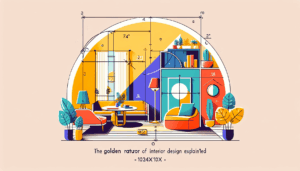The Golden Ratio, often denoted by the Greek letter phi (φ), is a mathematical concept that has fascinated artists, architects, and designers for centuries. It describes a specific ratio, approximately 1.618, that is believed to create aesthetically pleasing compositions. In the realm of interior design, understanding and applying the Golden Ratio can elevate a space’s harmony and balance, making it not only beautiful but also functional. In this blog, we’ll delve into what the Golden Ratio is, how it can be applied in interior design, and practical tips on incorporating it into your home.

What is the Golden Ratio?
The Golden Ratio is derived from a simple mathematical equation: if a line is divided into two parts, A and B, the ratio of the whole line (A + B) to the longer part (A) is the same as the ratio of the longer part (A) to the shorter part (B). This relationship results in a value of approximately 1.618, which is often referred to as the Divine Proportion.
Throughout history, the Golden Ratio has been observed in nature, art, and architecture. From the spirals of seashells to the proportions of the Parthenon in Greece, this ratio has been celebrated for its ability to create balance and harmony. In interior design, the Golden Ratio can guide the arrangement of furniture, the proportions of elements within a space, and the overall layout, leading to a more cohesive and inviting environment.
The Importance of the Golden Ratio in Interior Design
Applying the Golden Ratio in interior design can enhance a space in several ways:
1. Aesthetic Appeal: Spaces designed with the Golden Ratio are often perceived as more visually pleasing. This is due to our innate attraction to balanced proportions, which create a sense of order and tranquility.
2. Functional Layout: The Golden Ratio can help determine the optimal placement of furniture and decor, ensuring that a room feels both spacious and comfortable.
3. Highlighting Focal Points: By using the Golden Ratio, designers can create focal points that draw the eye and enhance the overall composition of a room.
4. Versatility: The Golden Ratio can be applied in various styles, from minimalist to eclectic, allowing for flexibility in design choices while maintaining aesthetic harmony.
How to Apply the Golden Ratio in Interior Design
1. Room Dimensions
One of the simplest ways to incorporate the Golden Ratio is through room dimensions. When designing a space, aim for dimensions that reflect the ratio. For example, if your room is 10 feet wide, the ideal length using the Golden Ratio would be approximately 16.18 feet. This principle can also apply to the height of the room and the size of windows, ensuring that all elements work harmoniously together.
2. Furniture Arrangement
When arranging furniture, consider the Golden Ratio for spacing and placement. For instance, if you have a coffee table that measures 48 inches long, the ideal width of the seating area should be about 29.6 inches (48 inches divided by 1.618). This proportion will help create a balanced and inviting layout.
3. Artwork and Decor
Artwork and decorative elements can also benefit from the Golden Ratio. When hanging art or choosing decor, consider the size relationships between different pieces. For example, a large painting can be paired with smaller frames or decor items that maintain the same ratio. This creates a visually appealing gallery wall or display.
4. Color Schemes
The Golden Ratio can guide color choices and distribution in a space. A common approach is the 60-30-10 rule, where 60% of the room is a dominant color, 30% is a secondary color, and 10% is an accent color. By adhering to this ratio, you can achieve a balanced and harmonious color palette that reflects the principles of the Golden Ratio.
5. Lighting
Lighting is an essential aspect of interior design that can be enhanced by the Golden Ratio. When selecting light fixtures, consider the size and placement in relation to the room’s dimensions. For example, if you have a dining room table that is 72 inches long, a chandelier above should ideally be about 44.5 inches wide (72 inches divided by 1.618) to create a balanced look.
Practical Tips for Implementing the Golden Ratio
– Sketch it Out: Before making significant changes to your space, sketch out your layout using the Golden Ratio. This can help visualize how different elements will interact and fit together.
– Use Grids: Create a grid based on the Golden Ratio to guide the placement of furniture and decor. This can serve as a blueprint for achieving balance in your design.
– Experiment with Proportions: Don’t be afraid to play with different proportions and arrangements. The Golden Ratio is a guideline, not a strict rule. Trust your instincts and adjust as needed for your unique space.
– Seek Inspiration: Look for examples of spaces that successfully incorporate the Golden Ratio. Analyze what makes them appealing and how you can adapt those concepts to your own design.
Conclusion
The Golden Ratio is a powerful tool in the world of interior design, capable of transforming a space into a harmonious and visually captivating environment. By understanding and applying this mathematical principle, you can create rooms that not only look stunning but also feel balanced and inviting. Whether you’re designing a new space or refreshing an existing one, consider the Golden Ratio as a guiding principle to elevate your interior design game. Embrace the beauty of proportion and let it inspire your next design project!
AI-Assisted Content Disclaimer
This article was created with AI assistance and reviewed by a human for accuracy and clarity.





Leave a Reply